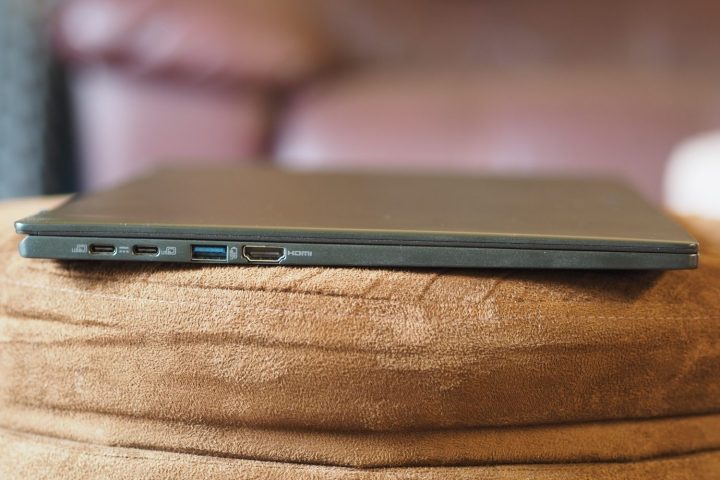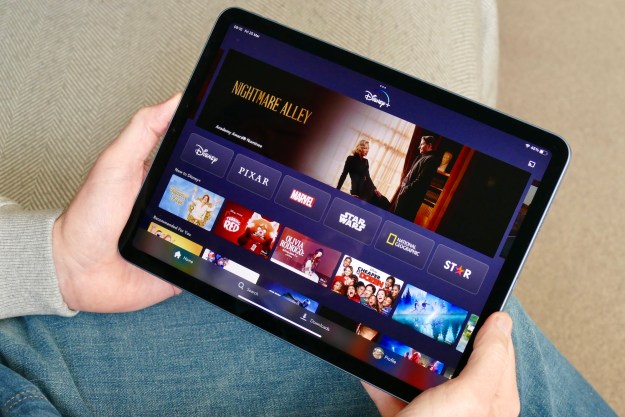
“The Acer Swift Edge is a remarkably thin and light 16-inch laptop with a class-leading OLED display, but it feels a bit flimsy and creative performance is lacking.”
- Uniquely thin and light
- Spectacular display
- Solid productivity performance
- Good battery life
- Moderately priced
- Flexible chassis
- Creative performance is lacking
- Keyboard is too loose
If you’re looking for a large-screen laptop with the power to run the most demanding creative apps, then machines like the (very expensive) Apple MacBook Pro 16 and (much more affordable) HP Envy 16 have you covered. They’re bulkier and heavier machines, though, and overkill for anyone who wants a 15-inch laptop (or larger) for simpler productivity multitasking and media consumption instead.
That’s where a laptop like the Acer Swift Edge SFA16-41 comes in, offering a 16-inch OLED
Specs
| Specs | |
| Dimensions | 14.04 inches x 9.54 inches x 0.51 inches |
| Weight | 2.58 pounds |
| Processor | AMD Ryzen 7 6800U |
| Graphics | AMD Radeon Graphics |
| RAM | 16GB LPDDR5 |
| Display | 16.0-inch 16:10 4K+ (3,840 x 2,400) OLED |
| Storage | 1TB PCIe Gen 4 SSD |
| Touch | No |
| Ports | 2 x USB-C 3.2 Gen 2 2 x USB-A 3.2 Gen 1 1 x HDMI 2.1 1 x 3.5mm audio jack |
| Wireless | Wi-Fi 6E and Bluetooth 5.2 |
| Webcam | 1080p |
| Operating system | Windows 11 |
| Battery | 54 watt-hour |
| Price | $1,500 |
Price and configurations
At the time of writing, there’s only one configuration of the Swift Edge, available from either Costco or directly from Acer. You’ll pay $1,500 for an AMD Ryzen 7 6800U CPU, 16GB of
Thin and light, but at what cost?

As mentioned above, the Swift Edge is ludicrously thin at 0.51 inches and light at 2.58 pounds. That’s less than most 14-inch
However, there are prices to pay for being this thin and this light.
To begin with, most

Another area where the low weight has an impact is in its battery capacity. The Swift Edge has just a 54 watt-hour battery, which is low for a laptop with a 16-inch
The Swift Edge was a decent performer in our battery tests, but the LG Gram 16 2-in-1 demonstrates how important battery size is to battery life while the MacBook Pro 16 demonstrates the efficiency of Apple’s ARM architecture.
| Web browsing | Video | PCMark 10 Applications |
|
| Acer Swift Edge (Ryzen 7 6800U) |
10 hours, 16 minutes | 11 hours, 5 minutes | 8 hours, 38 minutes |
| Asus Vivobook 17X (Core i7-12700H) |
5 hours, 11 minutes | 10 hours, 5 minutes | 6 hours, 48 minutes |
| LG Gram 16 2-in-1 (Core i7-1260P) |
11 hours, 31 minutes | 17 hours, 58 minutes | 16 hours, 39 minutes |
| Dell XPS 15 9520 (Core i7-12700H) |
9 hours, 38 minutes | 12 hours, 40 minutes | 11 hours, 14 minutes |
| Apple MacBook Pro 16 (Apple M1 Pro) |
18 hours, 35 minutes | 23 hours, 11 minutes | N/A |
Some ultrathin
Some people might find them to be too light, though. It’s not the worst keyboard I’ve tested, but it’s not the best, either. The touchpad is large and precise for a mechanical version, with buttons that are quiet enough, if a bit abrupt. The display isn’t touch-enabled, which I miss.
Another area where the thin design doesn’t force compromises is connectivity. Surprisingly, the Swift Edge has plenty of ports, although Thunderbolt 4 is lacking. That’s due to the AMD chipset, though, rather than the thin chassis.
I’d talk more about the laptop’s aesthetic, but there’s not much to say. The chassis is “Olivine Black,” and there’s zero bling. It’s a minimalist design like so many
Still, Acer managed to fit in a 1080p webcam, which is great, but there’s no infrared camera for Windows 11 Hello support. The fingerprint reader embedded in the power button works fine, though.
Not a lightweight display

A 16-inch display demands a high resolution to avoid jagged text and pixelated images. The Swift Edge runs at a productivity-friendly 16:10 aspect ratio to go with a
Whether you’re using the laptop for productivity work where you demand sharp, black text or consuming media, you’ll love this display. The Swift Edge isn’t fast enough, as we’ll see, for demanding creators, but if you need to edit a photo in a pinch, then the display will accommodate you.
| Brightness (nits) |
Contrast | sRGB gamut | AdobeRGB gamut | Accuracy DeltaE (lower is better) |
|
| Acer Swift Edge (OLED) |
382 | 27360:1 | 100% | 97% | 1.44 |
| Asus Vivobook 17X (IPS) |
278 | 660:1 | 65% | 48% | 3.39 |
| LG Gram 16 2-in-1 (IPS) |
323 | 1,230:1 | 100% | 87% | 2.82 |
| Lenovo ThinkPad Z16 (IPS) |
485 | 1,520:1 | 100% | 77% | 2.37 |
| HP Envy 16 (OLED) |
348 | 24,3010:1 | 100% | 97% | 0.74 |
The audio wasn’t as impressive, with just two downward-firing speakers providing sound that’s suitable for the occasional YouTube video and not much else. Some larger
Fast enough for demanding producers

There’s no doubt that the gorgeous, spacious OLED display begs for demanding creative work. However, the most powerful creative applications make use of discrete GPUs to accelerate a variety of tasks, something that the Swift Edge doesn’t have. Given the thin chassis that already makes it difficult to move lots of air around, it’s impressive that Acer managed to pack in an eight-core/16-thread AMD Ryzen 7 6800U CPU. That’s a low-power CPU (15 watts to 28 watts) aimed at thin and light
Ultimately, you can expect solid productivity performance in CPU-intensive tasks, but you’ll be limited in creative work due to the slower integrated AMD Radeon Graphics. And I saw that productivity performance in our suite of benchmarks. In the table below, which lists results in both balanced and performance modes, I compare the Swift Edge to other large machines without discrete GPUs. Note that the Acer’s performance mode was much slower than its balanced mode, indicating poor tuning or thermal throttling issues caused by opening up the CPU. It’s best to keep it in normal mode.
Intel’s H-series 12th-gen CPUs were faster than the AMD chip, but they’re higher-clocked processors that burn more power. The Swift Edge’s results are competitive enough that the laptop can be depended on to churn through demanding productivity workflows while enjoying longer battery life.
| Geekbench (single / multi) |
Handbrake (seconds) |
Cinebench R23 (single / multi) |
PCMark 10 Complete |
|
| Acer Swift Edge (Ryzen 7 6800U) |
Bal: 1,456 / 7,085 Perf: 1,457 / 6,708 |
Bal: 115 Perf: 154 |
Bal: 1,466 / 8,543 Perf: 1,316 / 5,487 |
5,926 |
| Asus Vivobook 17X (Core i7-12700H) |
Bal: 1,698 / 8,339 Perf: 1,714 / 8,558 |
Bal: 93 Perf: 87 |
Bal: 1,681 / 11,083 Perf: 1,717 / 12,552 |
5,665 |
| Lenovo ThinkPad Z16 (Ryzen 7 Pro 6850H) |
Bal: 1,360 / 8,648 Perf: 1,365 / 8,679 |
Bal: 88 Perf: 87 |
Bal: 1,376 / 10,938 Perf: 1,374 / 11,553 |
6,260 |
| Dell XPS 15 9520 (Core i7-12700H) |
Bal: 1,470 / 9,952 Perf: 1,714 / 11,053 |
Bal: 100 Perf: 77 |
Bal: 1,509 / 11,578 Perf: 1,806 / 13,313 |
5,559 |
| Asus ZenBook Pro 14 Duo (Core i7-12700H) |
Bal: 1,829 / 10,819 Perf: N/A |
Bal: 94 Perf: 82 |
Bal: 1,793 / 12,046 Perf: N/A |
6,242 |
| LG Gram 16 2-in-1 (Core i7-1260P) |
Bal: 1,682 / 9,035 Perf: 1,686 / 9,479 |
Bal: 137 Perf: 113 |
Bal: 1,524 / 6,314 Perf: 1,663 / 8,396 |
5,404 |
Mission accomplished, with compromises
There are likely plenty of people who want a large laptop with a spectacular display for productivity and media consumption, but they don’t want to lug around a bulky, heavy machine. At least, that’s what Acer hopes. For those people, the Swift Edge is a remarkable laptop.
It’s incredibly thin and light, and yet it provides solid productivity performance, good enough battery life, and an awesome visual experience. That justifies the premium price of $1,500, and I’m happy that it doesn’t cross the $2,000 barrier, where it would be too expensive. There aren’t many other
Editors' Recommendations
- What is screen door effect in VR?
- Apple could soon put an M3 chip in its worst laptop
- The best HP laptops
- The most common Zoom problems and how to fix them
- The best desktop computers for 2023: Dell, HP, Apple, and more









